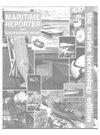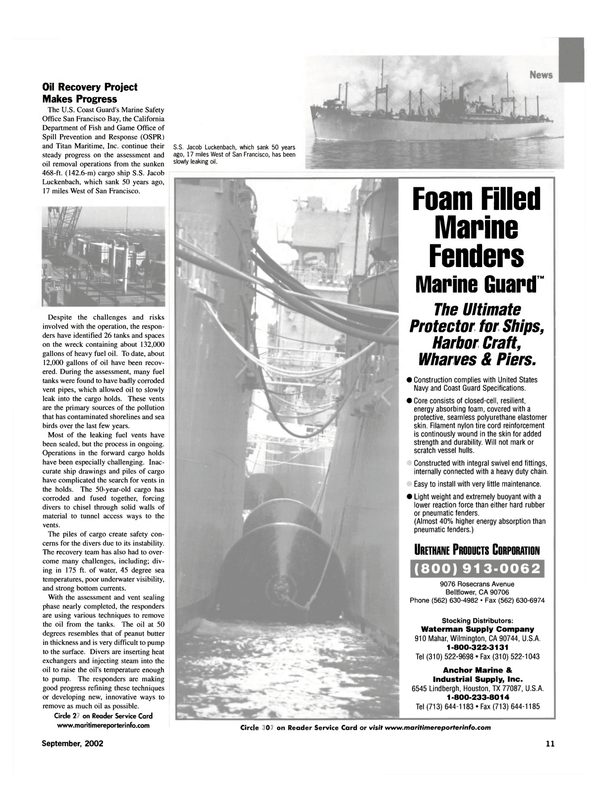
Oil Recovery Project Makes Progress
The U.S. Coast Guard's Marine Safety Office San Francisco Bay, the California Department of Fish and Game Office of Spill Prevention and Response (OSPR) and Titan Maritime, Inc. continue their steady progress on the assessment and oil removal operations from the sunken 468-ft. (142.6-m) cargo ship S.S. Jacob Luckenbach, which sank 50 years ago, 17 miles West of San Francisco.
Despite the challenges and risks involved with the operation, the responders have identified 26 tanks and spaces on the wreck containing about 132,000 gallons of heavy fuel oil. To date, about 12,000 gallons of oil have been recovered.
During the assessment, many fuel tanks were found to have badly corroded vent pipes, which allowed oil to slowly leak into the cargo holds. These vents are the primary sources of the pollution that has contaminated shorelines and sea birds over the last few years.
Most of the leaking fuel vents have been sealed, but the process in ongoing.
Operations in the forward cargo holds have been especially challenging. Inaccurate ship drawings and piles of cargo have complicated the search for vents in the holds. The 50-year-old cargo has corroded and fused together, forcing divers to chisel through solid walls of material to tunnel access ways to the vents.
The piles of cargo create safety concerns for the divers due to its instability.
The recovery team has also had to overcome many challenges, including; diving in 175 ft. of water, 45 degree sea temperatures, poor underwater visibility, and strong bottom currents.
With the assessment and vent sealing phase nearly completed, the responders are using various techniques to remove the oil from the tanks. The oil at 50 degrees resembles that of peanut butter in thickness and is very difficult to pump to the surface. Divers are inserting heat exchangers and injecting steam into the oil to raise the oil's temperature enough to pump. The responders are making good progress refining these techniques or developing new, innovative ways to remove as much oil as possible.
Circle 228 on Reader Service Card or visit www.maritimereporterinfo.com
Read Oil Recovery Project Makes Progress in Pdf, Flash or Html5 edition of September 2002 Maritime Reporter
Other stories from September 2002 issue
Content
- Recent Wartsila Four-Stroke Engine Developments page: 52D
- CMR: Monitoring is Control page: 52G
- Caterpillar Offers New C12 Engine page: 52H
- GAO Affirms DD(X) Contract to Gold Team page: 8
- Northrop (arumman Unloads Hair-built 1 roiect America ohip to JNLL page: 10
- Oil Recovery Project Makes Progress page: 11
- Crowley Christens Tug Response page: 14
- NASSCO and TOTE Christen Midnight Sun page: 15
- " T a x i ! ? " page: 16
- Kvaerner Masa-Yards Delivers Carnival Legend page: 17
- Crewing and Maritime Security page: 18
- President Cuts USCG Funding page: 21
- Bollinger Builds Next Generation Liftboat page: 21
- Three Hulls = One Ship page: 22
- What Hull Shape Is Best? page: 27
- Advances in CAD and CAM System Integration page: 30
- Precision Ship-Handling Writ Large page: 34
- NautiCast Offers AIS Solution page: 38
- Modern Maid-of-All Work page: 40
- Green GL Passports For Boxship Trio page: 40
- A German Ferry for All Harbors page: 43
- Optimal Electric Ship Propulsion Solution page: 50
- New Technology Has Promising Maritime Applications page: 52
- Stern Tube Lubricant Absorbs Costs page: 58
- The New Hunter/Gatherers page: 60
- Interactive Format for Repair and Conversion's Main Event page: 64
- New England's Fall Foliage Is Setting For SNAME 2002 page: 66
- Fleet Privatizations Expected Soon For Lithuanian Companies page: 67
- Halter is Back page: 68
- Halter Moss Point: This Way is Up page: 71
- Stealthy ROV Keeps Divers Out of Danger page: 73
- New Center for Fire and Evacuation Safety page: 75
- U.S. Market: Foundation for the Future page: 78
- Port Authority Receives Approval page: 87


